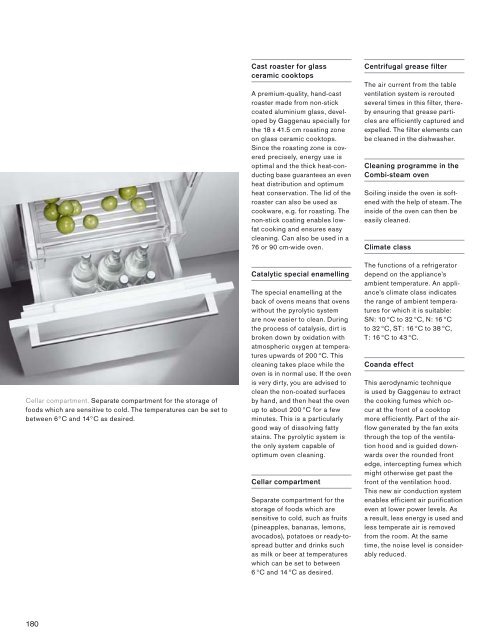The Gaggenau Magazine. Edition 2010/2011. T he G ag g enau M ...
The Gaggenau Magazine. Edition 2010/2011. T he G ag g enau M ...
The Gaggenau Magazine. Edition 2010/2011. T he G ag g enau M ...
You also want an ePaper? Increase the reach of your titles
YUMPU automatically turns print PDFs into web optimized ePapers that Google loves.
Cellar compartment. Separate compartment for t<strong>he</strong> stor<strong>ag</strong>e of<br />
foods which are sensitive to cold. <strong>T<strong>he</strong></strong> temperatures can be set to<br />
between 6°C and 14°C as desired.<br />
Cast roaster for glass<br />
ceramic cooktops<br />
A premium-quality, hand-cast<br />
roaster made from non-stick<br />
coated aluminium glass, developed<br />
by <strong>G<strong>ag</strong>g<strong>enau</strong></strong> specially for<br />
t<strong>he</strong> 18 x 41.5 cm roasting zone<br />
on glass ceramic cooktops.<br />
Since t<strong>he</strong> roasting zone is covered<br />
precisely, energy use is<br />
optimal and t<strong>he</strong> thick <strong>he</strong>at-conducting<br />
base guarantees an even<br />
<strong>he</strong>at distribution and optimum<br />
<strong>he</strong>at conservation. <strong>T<strong>he</strong></strong> lid of t<strong>he</strong><br />
roaster can also be used as<br />
cookware, e.g. for roasting. <strong>T<strong>he</strong></strong><br />
non-stick coating enables lowfat<br />
cooking and ensures easy<br />
cleaning. Can also be used in a<br />
76 or 90 cm-wide oven.<br />
Catalytic special enamelling<br />
<strong>T<strong>he</strong></strong> special enamelling at t<strong>he</strong><br />
back of ovens means that ovens<br />
without t<strong>he</strong> pyrolytic system<br />
are now easier to clean. During<br />
t<strong>he</strong> process of catalysis, dirt is<br />
broken down by oxidation with<br />
atmosp<strong>he</strong>ric oxygen at temperatures<br />
upwards of 200°C. This<br />
cleaning takes place while t<strong>he</strong><br />
oven is in normal use. If t<strong>he</strong> oven<br />
is very dirty, you are advised to<br />
clean t<strong>he</strong> non-coated surfaces<br />
by hand, and t<strong>he</strong>n <strong>he</strong>at t<strong>he</strong> oven<br />
up to about 200°C for a few<br />
minutes. This is a particularly<br />
good way of dissolving fatty<br />
stains. <strong>T<strong>he</strong></strong> pyrolytic system is<br />
t<strong>he</strong> only system capable of<br />
optimum oven cleaning.<br />
Cellar compartment<br />
Separate compartment for t<strong>he</strong><br />
stor<strong>ag</strong>e of foods which are<br />
sensitive to cold, such as fruits<br />
(pineapples, bananas, lemons,<br />
avocados), potatoes or ready-tospread<br />
butter and drinks such<br />
as milk or beer at temperatures<br />
which can be set to between<br />
6°C and 14°C as desired.<br />
Centrifugal grease filter<br />
<strong>T<strong>he</strong></strong> air current from t<strong>he</strong> table<br />
ventilation system is rerouted<br />
several times in this filter, t<strong>he</strong>reby<br />
ensuring that grease particles<br />
are efficiently captured and<br />
expelled. <strong>T<strong>he</strong></strong> filter elements can<br />
be cleaned in t<strong>he</strong> dishwas<strong>he</strong>r.<br />
Cleaning programme in t<strong>he</strong><br />
Combi-steam oven<br />
Soiling inside t<strong>he</strong> oven is softened<br />
with t<strong>he</strong> <strong>he</strong>lp of steam. <strong>T<strong>he</strong></strong><br />
inside of t<strong>he</strong> oven can t<strong>he</strong>n be<br />
easily cleaned.<br />
Climate class<br />
<strong>T<strong>he</strong></strong> functions of a refrigerator<br />
depend on t<strong>he</strong> appliance’s<br />
ambient temperature. An appliance’s<br />
climate class indicates<br />
t<strong>he</strong> range of ambient temperatures<br />
for which it is suitable:<br />
SN: 10°C to 32°C, N: 16°C<br />
to 32°C, ST: 16°C to 38°C,<br />
T : 16 °C to 43°C.<br />
Coanda effect<br />
This aerodynamic technique<br />
is used by <strong>G<strong>ag</strong>g<strong>enau</strong></strong> to extract<br />
t<strong>he</strong> cooking fumes which occur<br />
at t<strong>he</strong> front of a cooktop<br />
more efficiently. Part of t<strong>he</strong> airflow<br />
generated by t<strong>he</strong> fan exits<br />
through t<strong>he</strong> top of t<strong>he</strong> ventilation<br />
hood and is guided downwards<br />
over t<strong>he</strong> rounded front<br />
edge, intercepting fumes which<br />
might ot<strong>he</strong>rwise get past t<strong>he</strong><br />
front of t<strong>he</strong> ventilation hood.<br />
This new air conduction system<br />
enables efficient air purification<br />
even at lower power levels. As<br />
a result, less energy is used and<br />
less temperate air is removed<br />
from t<strong>he</strong> room. At t<strong>he</strong> same<br />
time, t<strong>he</strong> noise level is considerably<br />
reduced.<br />
180



